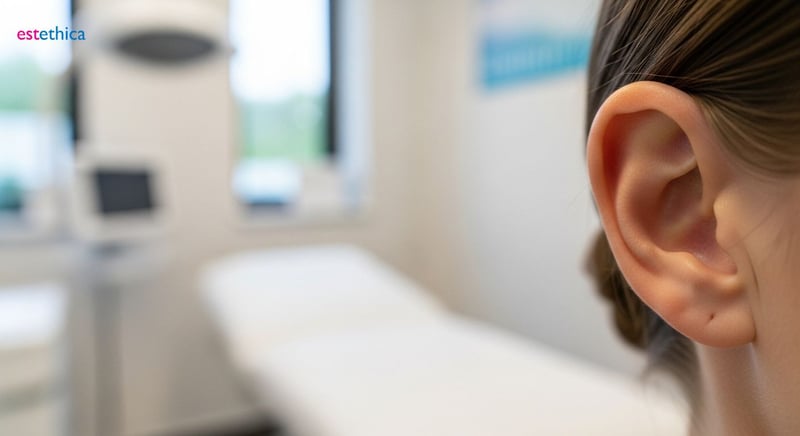Unlock Confidence: Your Guide to Cosmetic Ear Surgery
Transform your appearance and confidence with cutting-edge ear surgery. Learn about innovative procedures tailored to you.
Welcome to our comprehensive guide on cosmetic ear surgery—a transformative journey towards enhancing your self-confidence through tailored ear reshaping and ear pinning solutions. Discover how these innovative procedures not only enhance aesthetic appeal but also address functional aspects.
Ear Reshaping: Understanding Your Options for a Balanced Look
Exploring Surgical Ear Reshaping Techniques
Cosmetic ear surgery, also known as otoplasty, encompasses various surgical methods designed to reshape the ears. These techniques can address concerns such as protruding ears, overly large ears (macrotia), or misshapen ears due to injury or birth defects. Traditional surgical approaches involve making incisions behind the ear to access and reshape the cartilage. Sutures are then used to secure the new shape and close the incisions. According to the American Society of Plastic Surgeons, patient satisfaction rates for otoplasty are generally high, with many individuals reporting improved self-esteem and body image.
- Cartilage Reshaping: This method involves sculpting the existing cartilage to create a more aesthetically pleasing shape. For example, scoring the cartilage can make it easier to bend and reshape, allowing surgeons to reduce the projection of prominent ears.
- Ear Reduction: For individuals with macrotia, ear reduction surgery removes excess cartilage and skin to achieve a more proportionate ear size. This technique ensures the ears are in harmony with the rest of the facial features.
- Lobe Repair: Surgical techniques can also correct split or stretched earlobes, often resulting from wearing heavy earrings or trauma. This procedure restores the natural shape of the earlobe.
Choosing the right surgical technique depends on the patient's unique anatomy and desired outcome. Consultation with a skilled and experienced surgeon is essential to determine the most appropriate approach for achieving a balanced and natural-looking result. Aesthetic Ear Restoration through surgery addresses structural and form issues, offering increased confidence.
Non-Surgical Innovations in Ear Reshaping
Emerging non-surgical options offer alternatives to traditional ear surgery, particularly for correcting protruding ears in younger patients. These methods typically involve the use of ear molding systems or specialized adhesives to reshape the cartilage without incisions. Non surgical ear reshaping options are gaining popularity due to their minimally invasive nature and reduced recovery time. One study published in the "Aesthetic Surgery Journal" indicated that early intervention with ear molding in infants can effectively correct ear deformities in many cases.
- Ear Molding for Infants: Ear molding is most effective when performed within the first few weeks of life, while the cartilage is still soft and pliable due to circulating maternal hormones. This involves using a custom-fitted mold to gently reshape the ear over several weeks or months.
- Adhesive Techniques: For older children and adults, temporary reshaping can sometimes be achieved with specialized adhesives that hold the ear in a corrected position. These methods are best suited for minor corrections and may not provide permanent results.
- Thread suspension: A minimally invasive procedure using threads to reshape and reposition the ear. This method may be suitable for those seeking subtle changes.
While non-surgical options may not be suitable for all types of ear deformities, they offer a promising alternative for individuals seeking less invasive solutions. Considerations are necessary when evaluating these cosmetic treatments. The ideal approach depends on individual needs and goals.

Ear Pinning Unveiled: Correcting Protruding Ears for All Ages
Ear Pinning Techniques Across Age Groups
Ear pinning, or otoplasty, is a transformative procedure that enhances facial harmony by correcting protruding ears. Its effectiveness spans diverse age groups, from young children to adults, each benefiting uniquely from the procedure. The primary goal is to reposition the ears closer to the head, creating a more balanced and natural appearance. Understanding the distinct approaches required for different age groups is crucial for achieving optimal results. The impact of Ear Surgery Confidence Boosts self-esteem, especially in younger patients.
- Children: Otoplasty is often performed on children around the age of five or six, once their ear cartilage has reached nearly full size. Early correction can prevent psychological distress and teasing.
- Teenagers: Teenagers seek ear pinning to improve their appearance and fit in with their peers. Otoplasty at this age addresses long-standing self-consciousness.
- Adults: Adults choose ear pinning for personal satisfaction and to correct issues that may have bothered them for years. They often have a clearer understanding of their aesthetic goals.
Each age group presents unique considerations, with surgical techniques tailored to meet specific needs and expectations. Open communication between the patient (or their parents) and the surgeon is essential for a successful outcome. Otoplasty surgery aims to improve quality of life by addressing aesthetic concerns.
Variations in Ear Pinning Procedures
The specific ear pinning procedure varies based on the patient's age and the desired aesthetic outcome. In children, the cartilage is more pliable, allowing for easier reshaping. Adults, however, may require more extensive techniques to achieve the desired correction. Precise planning and execution are crucial for achieving natural-looking results. Aesthetic Ear Restoration focuses on techniques that deliver subtle improvements.
- Suturing Techniques: Sutures are strategically placed to reshape the cartilage and hold the ear in its new position. This method is commonly used in both children and adults.
- Cartilage Scoring: In some cases, the cartilage may need to be scored or partially removed to achieve the desired shape. This approach is more common in adults with stiffer cartilage.
- Combination Approaches: Surgeons often combine different techniques to achieve the best possible outcome. This personalized approach ensures that each patient's unique needs are met.
Regardless of the specific technique used, the goal of ear pinning is to create a natural-looking and balanced appearance that enhances the patient's overall facial aesthetics. A skilled surgeon will carefully assess the patient's anatomy and recommend the most appropriate procedure to achieve their desired results. Individuals explore Otoplasty to achieve balanced facial symmetry.

Beyond Aesthetics: The Functional Benefits of Ear Surgery
Restoring Auditory Function with Ear Surgery
While cosmetic ear surgery is often associated with aesthetic improvements, it can also offer significant functional benefits. Individuals with congenital ear conditions or those who have experienced trauma to the ear may suffer from impaired auditory capabilities. Ear surgery, such as reconstructive procedures, can help restore the ear's natural structure and improve its ability to capture and transmit sound waves effectively. Aesthetic Ear Restoration focuses not only on appearance but also on restoring natural function.
- Microtia Reconstruction: This procedure addresses underdeveloped ears, often improving hearing by creating a more functional ear structure.
- Traumatic Injury Repair: Ear surgery can repair damage caused by accidents, burns, or other trauma, restoring both appearance and auditory function.
- Correction of Congenital Deformities: Addressing deformities present from birth can enhance hearing capabilities and overall quality of life.
By addressing underlying structural issues, ear surgery can enhance auditory capabilities and improve the patient's ability to perceive sounds accurately. Individuals explore Otoplasty to improve existing conditions. A balanced approach considers both form and function.
Alleviating Discomfort and Correcting Congenital Conditions
Beyond improving hearing, ear surgery can also alleviate discomfort associated with certain congenital ear conditions. For example, individuals with constricted or cupped ears may experience pain or irritation due to the abnormal shape of their ears. Corrective surgery can reshape the ear, reducing pressure and alleviating discomfort. According to a study published in the "Journal of Craniofacial Surgery," corrective ear surgery can significantly improve the quality of life for individuals with congenital ear deformities. Surgical intervention, including otoplasty, addresses both structural and aesthetic concerns.
- Reducing Pressure: Reshaping the ear can eliminate areas of excessive pressure, reducing pain and discomfort.
- Improving Hygiene: Correcting deformities can make it easier to keep the ears clean, preventing infections and irritation.
- Enhancing Comfort: Overall, corrective ear surgery can significantly improve the patient's comfort and well-being.
Corrective surgery can significantly improve the patient's comfort and well-being. Ear pinning offers functional benefits by addressing physical discomfort. The approach prioritizes functional improvements alongside aesthetic enhancements.

Otoplasty Recovery: What to Expect After Your Ear Surgery Procedure
Navigating the Initial Days After Otoplasty
The immediate aftermath of ear surgery requires careful attention to ensure proper healing and minimize complications. Patients can typically expect some discomfort, swelling, and bruising around the ears. Pain management is crucial during this phase, with prescription pain medication often recommended to alleviate any post-operative pain. It's essential to follow the surgeon's instructions regarding medication and wound care to facilitate a smooth recovery. Ear reshaping aims to provide comfort and improved aesthetics. According to medical professionals, adherence to post-operative guidelines significantly impacts the overall outcome of the surgery.
- Managing Discomfort: Pain medication should be taken as prescribed to keep discomfort at bay. Applying cold compresses can also help reduce swelling and ease pain.
- Protecting Incisions: Keeping the incision sites clean and dry is essential to prevent infection. Follow the surgeon's instructions for wound care meticulously.
- Rest and Elevation: Getting plenty of rest and keeping the head elevated can minimize swelling and promote healing. Avoid strenuous activities that could put pressure on the ears.
Proper care and attention during the initial days post-otoplasty are essential for setting the stage for a successful recovery. Patients should maintain consistent communication with their surgical team if any concerns arise during this critical period. Ear pinning may require wearing a bandage for a specified time. Each patient’s recovery process can be personalized.
Long-Term Recovery and Aftercare Strategies
The long-term recovery process following ear surgery involves several key strategies to ensure optimal results and minimize the risk of complications. While initial discomfort subsides within a few weeks, the ears continue to heal and settle into their new shape over several months. Consistent aftercare, including protecting the ears from trauma and attending follow-up appointments, is crucial during this period. Ear Surgery Confidence Boost comes with adherence to aftercare instructions. The American Academy of Facial Plastic and Reconstructive Surgery emphasizes the importance of long-term follow-up care for otoplasty patients.
- Wearing a Headband: Your surgeon might recommend wearing a headband, especially during sleep, to protect the ears and maintain their new position.
- Avoiding Trauma: Take precautions to avoid any trauma or impact to the ears, such as during sports or other physical activities.
- Sun Protection: Protect the ears from excessive sun exposure by wearing a hat or applying sunscreen to the area.
Long-term aftercare not only supports the healing process but also helps ensure the longevity of the results achieved through otoplasty. Patients who adhere to their surgeon's recommendations are more likely to enjoy a successful and satisfying outcome. Innovative Ear Reshaping Techniques provide lasting results. Patients need to follow after-care instructions.
Understanding Otoplasty: A Comprehensive Guide
Innovative Cartilage Reshaping Techniques for Aesthetic Ear Restoration
estethica employs state-of-the-art cartilage reshaping techniques, including scoring and suturing, to correct ear deformities and achieve a balanced aesthetic appearance. These methods are tailored to each patient's unique anatomy, ensuring natural-looking results and improved self-confidence.
estethica's surgeons are highly skilled in performing various otoplasty procedures, from traditional surgical methods to minimally invasive non-surgical options like ear molding and thread suspension. Their expertise ensures comprehensive care, addressing both aesthetic and functional aspects of ear surgery. estethica’s commitment to staying at the forefront of cosmetic surgery guarantees patients receive the most effective and advanced treatments available.
Rigorous Post-Operative Care and Follow-Up for Enhanced Otoplasty Recovery
estethica emphasizes a comprehensive and supportive recovery process following ear surgery, providing patients with detailed post-operative instructions and consistent follow-up care. This includes pain management, wound care, and strategies to minimize swelling and protect the ears during healing. estethica's commitment to patient well-being ensures a smooth and successful recovery, leading to long-lasting results and patient satisfaction.
Patients at estethica benefit from the hospital's focus on minimizing discomfort and promoting optimal healing following otoplasty procedures. The hospital's holistic approach, combining surgical excellence with compassionate aftercare, results in high patient satisfaction and improved quality of life. This patient-centric approach ensures that individuals feel supported throughout their entire journey, from initial consultation to final recovery.
Frequently Asked Questions
What is otoplasty and who is a suitable candidate for Aesthetic Ear Restoration?
What are the functional benefits of ear surgery beyond aesthetics?
What can I expect during the recovery period after undergoing an Ear Surgery Confidence Boost procedure?
Is ear pinning only for children, or can Ear Pinning for Teenagers and adults benefit from it as well?
Achieve your aesthetic goals with estethica's personalized treatment plans and expert care.
📞 Call Now for Your Free Consultation!